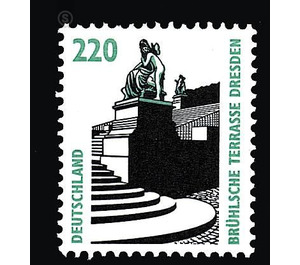Postage stamps: Places of interest - Germany / Federal Republic of Germany 1997 - 220 Pfennig
Theme: Art & Culture
| Country | Germany / Federal Republic of Germany |
| Issue Date | 1997 |
| Face Value | 220.00 |
| Color | black white |
| Perforation | K 14 |
| Printing Type | indirect 2-color letterpress |
| Stamp Type | Postage stamp |
| Item Type | Stamp |
| Chronological Issue Number | 1809 |
| Chronological Chapter | GER-BRD |
| SID | 400871 |
| In 48 Wishlists | |
Among the urban attractions of the state capital of Dresden, the Brühl Terrace is the special interest of visitors. Due to its location on the Elbe, the building, which dates back to 1550, provides a comprehensive view of the vastness of the Strom Valley. The approximately 500 m long, up to 10 m high and 20 to 200 m wide system was built as part of the re-fortification of the Saxon residence city, by which the Neumarkt was included with the Frauenkirche in the walled old town area. After the Dresden fortification had lost their fortification significance, donated in 1739 Elector Friedrich August II the elbseitigen part of his favorite Count Heinrich Brühl. The then designed, but only in relics preserved Baroque gardens gave the fortification its present name. Decisive for the public urban integration of the Brühl Terrace was the wide open staircase to the Palace Square built in 1814 with the sculptures of the "Four Times of the Day" by Johannes Schilling, which were replaced in 1898 by the existing bronze casts. Today, the monumental buildings of historicism bordering the complex are decisive for the urban planning effect of Brühl's Terrace: the old Saxon Landtag, the College of Fine Arts and the Albertinum. (Text: Saxon State Ministry of Economics and Arts, Dresden)


